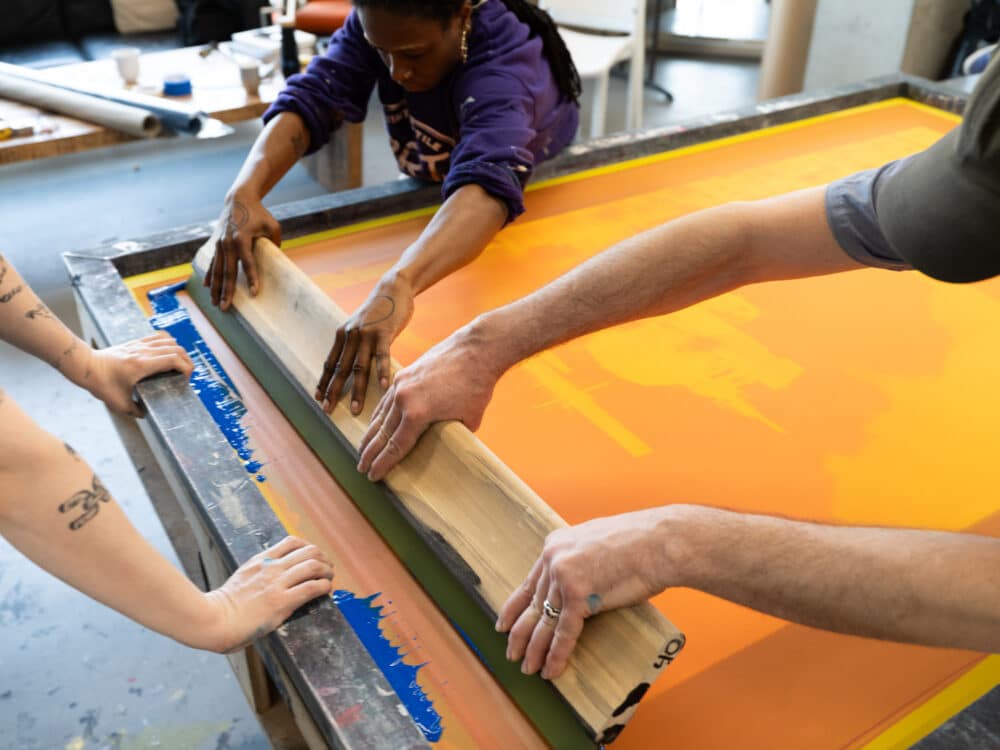The Essential Overview to Recognizing Screen Printing and Its Versatile Utilizes
Screen printing has a rich background that goes back to old times, advancing right into an advanced strategy used across various industries today. This guide checks out the complexities of the screen printing process, describing its applications in marketing, style, and home decoration - 10:9 Design near me. Recognizing these fundamentals can open up innovative possibility for both creative and commercial projects. The following sections will disclose essential pointers and techniques to improve one's screen printing endeavors
The History of Screen Printing
Screen printing has origins that map back centuries, its development mirrors the technical and artistic improvements of numerous societies. Coming from old China, the technique was initially utilized for enhancing fabrics and later infect Japan, where it became indispensable to Ukiyo-e woodblock printing. The approach moved to Europe in the 18th century, where it got popularity among craftsmens and business printers. The creation of image solution in the 20th century changed screen printing, enabling for even more detailed layouts and greater performance. Musicians like Andy Warhol further propelled its popularity, using the tool to produce renowned jobs that blended commercialism and great art. By the late 20th century, screen printing had actually established itself as a flexible technique, used in vogue, advertising, and art. Today, it continues to evolve, incorporating digital innovation and expanding its applications throughout various sectors.
The Screen Printing Refine Explained
Screen printing changes artistic visions into concrete designs with a collection of specific actions. An image is produced and after that transferred onto a screen, commonly made of fine mesh textile extended over a framework. A light-sensitive solution is related to the screen, which is exposed to light, solidifying in locations not covered by the picture. After washing out the unhardened solution, a pattern is created.
Next, the screen is put over the substratum, whether it be textile, paper, or one more material. Ink is after that pressed with the open locations of the stencil utilizing a squeegee, depositing the layout onto the substrate below. This procedure can be duplicated for several shades, needing different screens for every tone. Finally, the printed product is treated utilizing warm to guarantee the ink adheres appropriately, leading to a long lasting, lively layout on-line.
Types of Screen Printing Techniques

In addition, specialty strategies, such as discharge screen printing, get rid of color from the material to develop softer prints, while foil screen printing uses metallic foil to attain a glossy coating (10:9 Design Texas). Each technique offers unique features, accommodating get more info various imaginative demands and manufacturing scales, ultimately expanding the possibilities within the screen printing domain name
Applications of Screen Printing in Numerous Industries

In addition, the signage and advertising and marketing fields use screen printing for producing attractive screens and banners. This technique allows for vibrant colors and complex layouts that record interest. In electronic devices, screen printing is used for applying conductive inks to circuit card, vital for part links. The home decoration sector embraces screen printing to create unique styles on fabrics and wall art. Overall, screen printing works as a crucial tool throughout diverse fields, enhancing products with customized and aesthetically attractive graphics.
Tips for Successful Screen Printing Projects
While taking on a screen printing task, cautious interest to information can significantly enhance the final end result. Choosing top quality materials is essential; this includes the screen, inks, and substratums. Making use of proper mesh matters can impact ink deposition and information resolution. Prep work is just as crucial; thorough cleansing of displays and correct exposure times ensure crisp prints.
Next off, accurate enrollment is vital for multi-color prints. Using alignment tools can assist attain exact layering. Furthermore, testing prints on scrap materials before manufacturing aids determine prospective problems without throwing away resources.

Frequently Asked Inquiries
What Materials Are Finest for Screen Printing on Material?
Cotton and polyester blends are suitable for screen printing on material because of their toughness and ink absorption. In addition, specialized materials like silk or canvas can produce one-of-a-kind textures and surfaces, boosting the general layout quality.
Just how Do I Tidy and Maintain Screen Printing Equipment?
To cleanse and preserve screen printing equipment, one must routinely wash screens with proper solvents, evaluate mops for wear, oil relocating parts, and shop all things in a completely dry, dust-free setting to prolong their life-span.
What Are the Environmental Influences of Screen Printing?
Screen printing can have significant ecological influences, consisting of chemical waste from inks and solvents, water use during cleaning procedures, and energy usage. Sustainable practices and eco-friendly products are crucial for lessening these adverse impacts.
Can Screen Printing Be Done in the house Successfully?
Screen printing can be effectively done at home with the right products and strategies. Hobbyists can create quality prints, though success relies on their skill level, equipment, and understanding of the procedure included.
What Are the Prices Linked With Beginning a Display Printing Service?

Beginning a screen printing organization includes costs for tools, materials, and work space. Initial costs usually vary from a couple of hundred to several thousand dollars, depending on the scale, top quality of machinery, and preferred production ability.
Screen printing has a rich history that dates back to old times, developing into an innovative method made use of across various sectors today. An additional method, rotating screen printing, employs round displays, promoting continual printing on textile rolls, therefore enhancing performance for large manufacturings. Additionally, specialized techniques, such as discharge screen printing, remove dye from the material to produce softer prints, while foil screen printing uses metal foil to accomplish a shiny surface. In the style market, screen printing is extensively utilized to develop lively layouts on clothing, enabling brands to display their distinct designs. Cotton and polyester blends are suitable for screen printing on fabric due to their durability and ink absorption.